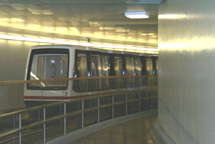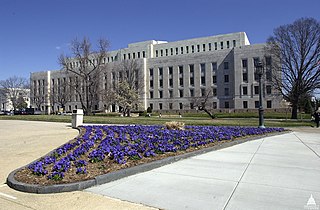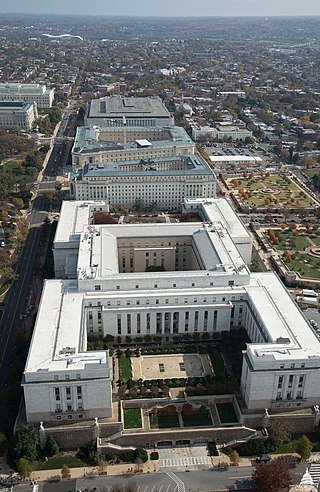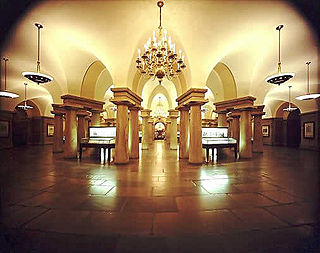
The subway system of the United States Capitol Complex in Washington, D.C., consists of three underground electric people mover systems that connect the United States Capitol to several congressional office buildings – all of the Senate buildings and one of the House buildings.

Pierre "Peter" Charles L'Enfant was an American-French military engineer who in 1791 designed the basic plan for Washington, D.C., the capital city of the United States. His work is known today as the L'Enfant Plan. He also inspired the street plan for Detroit, Michigan.

The Old Brick Capitol in Washington, D.C., served as the temporary Capitol of the United States from 1815 to 1819. The building was a private school, a boarding house, and, during the American Civil War, a prison known as the Old Capitol Prison. It was demolished in 1929, and its site is now occupied by the U.S. Supreme Court building.

The Architect of the Capitol (AOC) is the federal agency responsible for the maintenance, operation, development, and preservation of the United States Capitol Complex. It is an agency of the legislative branch of the federal government and is accountable to the United States Congress and the Supreme Court. Both the agency and the head of the agency are called "Architect of the Capitol". The head of the agency is appointed to a 10-year term by the president of the United States, confirmed by the United States Senate, and is accountable to the president.

The history of Washington, D.C., is tied to its role as the capital of the United States. The site of the District of Columbia along the Potomac River was first selected by President George Washington. The city came under attack during the War of 1812 in an episode known as the Burning of Washington. Upon the government's return to the capital, it had to manage the reconstruction of numerous public buildings, including the White House and the United States Capitol. The McMillan Plan of 1901 helped restore and beautify the downtown core area, including establishing the National Mall, along with numerous monuments and museums.

Freedom Plaza, originally known as Western Plaza, is an open plaza in Northwest Washington, D.C., United States, located near 14th Street and Pennsylvania Avenue NW, adjacent to Pershing Park. The plaza features an inlay that partially depicts Pierre (Peter) Charles L'Enfant's plan for the City of Washington. The National Park Service administers the Plaza as part of its Pennsylvania Avenue National Historic Site and coordinates the Plaza's activities.

Washington's Tomb is an empty burial chamber two stories directly below the Rotunda of the United States Capitol building in Washington, DC. It was included in the original design of the building by William Thornton and intended to entomb the body of George Washington, the first President of the United States. The original design of the rotunda, and the Crypt beneath it, included a central glass floor allowing the public to view Washington's Tomb two floors below, but this was never implemented.

The Capitol Power Plant is a fossil-fuel burning power plant which provides steam and chilled water for the United States Capitol, the Supreme Court, the Library of Congress and 19 other buildings in the Capitol Complex. Located at 25 E St SE in southeast Washington, D.C., the CPP was the only coal-burning power plant in the District of Columbia, and it now it mostly uses natural gas. The plant has been serving the Capitol since 1910, and is under the administration of the Architect of the Capitol.

The United States Capitol Complex is a group of twenty buildings and facilities in Washington, D.C., that are used by the federal government of the United States. The buildings and grounds within the complex are managed and supervised by the architect of the Capitol.

The James Madison Memorial Building is one of three United States Capitol Complex buildings that house the Library of Congress. The building was constructed from 1971 to 1976, and serves as the official memorial to United States Founding Father and president James Madison. It is located between First and Second Streets SE on Independence Avenue, across for the main library Thomas Jefferson Building, in Washington, D.C. In addition to various book and multimedia collections, it houses the United States Copyright Office, which is under the administration of the Librarian of Congress.

The John Adams Building is the second oldest of the buildings of the Library of Congress of the United States. Built in the 1930s, it is named for John Adams, the second president, who signed the law creating the Library of Congress in 1800. The building is in the Capitol Hill district of Washington D.C. next to the library's main building in the Capitol Complex. The Adams building opened to the public on April 5, 1939, and before being named for the president in 1980, was simply called The Annex building. It is designed in a restrained but very detailed Art Deco style and faced in white Georgia marble. It is located on Second Street SE between Independence Avenue and East Capitol Street in Washington, DC.

The Ford House Office Building is one of the five office buildings containing U.S. House of Representatives staff in Washington, D.C., on Capitol Hill.

The congressional office buildings are the office buildings used by the United States Congress to augment the limited space in the United States Capitol. The congressional office buildings are part of the Capitol Complex, and are thus under the authority of the Architect of the Capitol and protected by the United States Capitol Police. The office buildings house the individual offices of each U.S. Representative and Senator as well as committee hearing rooms, staff rooms, multiple cafeterias, and areas for support, committee, and maintenance staff.

The Thurgood Marshall Federal Judiciary Building (TMFJB) at the crossroads of the Capitol Hill and NoMA neighborhoods in Washington, D.C., houses offices that support the work of the United States Courts, including the Administrative Office of the United States Courts, the Federal Judicial Center, the United States Sentencing Commission, and the Office of the Clerk of the Judicial Panel on Multidistrict Litigation.

The United States Capitol rotunda is the tall central rotunda of the United States Capitol in Washington, D.C. It has been described as the Capitol's "symbolic and physical heart". Built between 1818 and 1824, the rotunda is located below the Capitol dome, which was built between 1857 and 1866.
The United States Senate Library is the official library of the United States Senate. While the Library informally began in 1792, it was officially established in 1871 and today holds an estimated 220,000 volumes.

The United States Capitol crypt is the large circular room filled with forty neoclassical Doric columns directly beneath the United States Capitol rotunda. It was built originally to support the rotunda as well as offer an entrance to Washington's Tomb. It currently serves as a museum and a repository for thirteen statues of the National Statuary Hall Collection.

The Discovery of America is a large marble sculptural group, created by Luigi Persico, which adorned the front of the east façade of the United States Capitol building from 1844 to 1958, before being put into storage.

The L'Enfant Plan for the city of Washington is the urban plan developed in 1791 by Major Pierre (Peter) Charles L'Enfant for George Washington, the first president of the United States.

The O'Neill House Office Building is an office building in Washington, D.C., that houses offices of both the House of Representatives and the Department of Health and Human Services. It is named after former United States Congressman from Massachusetts and Speaker of the United States House of Representatives Thomas P. "Tip" O'Neill Jr. and located at 200 C Street Southwest in the Southwest Federal Center district, at the foot of Capitol Hill.




















